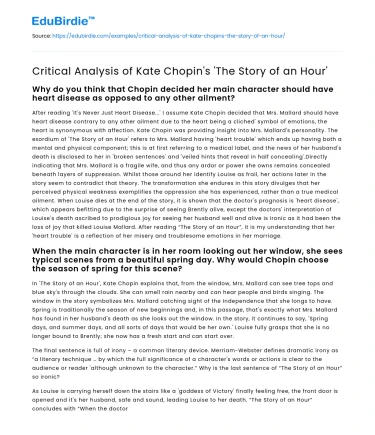Why do you think that Chopin decided her main character should have heart disease as opposed to any other ailment?
After reading 'It's Never Just Heart Disease...' I assume Kate Chopin decided that Mrs. Mallard should have heart disease contrary to any other ailment due to the heart being a cliched' symbol of emotions, the heart is synonymous with affection. Kate Chopin was providing insight into Mrs. Mallard's personality. The exordium of 'The Story of an Hour' refers to Mrs. Mallard having 'heart trouble' which ends up having both a mental and physical component; this is at first referring to a medical label, and the news of her husband's death is disclosed to her in 'broken sentences' and 'veiled hints that reveal in half concealing'.Directly indicating that Mrs. Mallard is a fragile wife, and thus any ardor or power she owns remains concealed beneath layers of suppression. Whilst those around her identify Louise as frail, her actions later in the story seem to contradict that theory. The transformation she endures in this story divulges that her perceived physical weakness exemplifies the oppression she has experienced, rather than a true medical ailment. When Louise dies at the end of the story, it is shown that the doctor's prognosis is 'heart disease', which appears befitting due to the surprise of seeing Brently alive, except the doctors' interpretation of Louise's death ascribed to prodigious joy for seeing her husband well and alive is ironic as it had been the loss of joy that killed Louise Mallard. After reading “The Story of an Hour”, it is my understanding that her 'heart trouble' is a reflection of her misery and troublesome emotions in her marriage.
When the main character is in her room looking out her window, she sees typical scenes from a beautiful spring day. Why would Chopin choose the season of spring for this scene?
In 'The Story of an Hour', Kate Chopin explains that, from the window, Mrs. Mallard can see tree tops and blue sky's through the clouds. She can smell rain nearby and can hear people and birds singing. The window in the story symbolizes Mrs. Mallard catching sight of the Independence that she longs to have. Spring is traditionally the season of new beginnings and, in this passage, that's exactly what Mrs. Mallard has found in her husband's death as she looks out the window. In the story, it continues to say, 'Spring days, and summer days, and all sorts of days that would be her own.' Louise fully grasps that she is no longer bound to Brently; she now has a fresh start and can start over.
Save your time!
We can take care of your essay
- Proper editing and formatting
- Free revision, title page, and bibliography
- Flexible prices and money-back guarantee
The final sentence is full of irony – a common literary device. Merriam-Webster defines dramatic irony as “a literary technique … by which the full significance of a character's words or actions is clear to the audience or reader 'although unknown to the character.” Why is the last sentence of “The Story of an Hour” so ironic?
As Louise is carrying herself down the stairs like a 'goddess of Victory' finally feeling free, the front door is opened and it's her husband, safe and sound, leading Louise to her death. “The Story of an Hour” concludes with “When the doctors came they said she died of heart disease—of joy that kills.” this portrays the ironic twist. The concluding line is to be rendered as a demonstration of the significance of Louise's realization of being able to have her freedom again. The irony is that she in fact did feel ephemeral pleasure with her newfound independence, but with the arrival of Mr. Mallard coming home, it is logical that she would be shocked rather than radiant. Losing her self-sufficiency obviously took a toll on her frail heart, taking away her perfervid bliss, and leading Louise to her tragic demise.
Did you like this example?
Make sure you submit a unique essay
Our writers will provide you with an essay sample written from scratch: any topic, any deadline, any instructions.
Cite this paper
-
APA
-
MLA
-
Harvard
-
Vancouver
Critical Analysis of Kate Chopin’s ‘The Story of an Hour’.
(2023, October 27). Edubirdie. Retrieved April 21, 2025, from https://hub.edubirdie.com/examples/critical-analysis-of-kate-chopins-the-story-of-an-hour/
“Critical Analysis of Kate Chopin’s ‘The Story of an Hour’.” Edubirdie, 27 Oct. 2023, hub.edubirdie.com/examples/critical-analysis-of-kate-chopins-the-story-of-an-hour/
Critical Analysis of Kate Chopin’s ‘The Story of an Hour’. [online].
Available at: <https://hub.edubirdie.com/examples/critical-analysis-of-kate-chopins-the-story-of-an-hour/> [Accessed 21 Apr. 2025].
Critical Analysis of Kate Chopin’s ‘The Story of an Hour’ [Internet]. Edubirdie.
2023 Oct 27 [cited 2025 Apr 21].
Available from: https://hub.edubirdie.com/examples/critical-analysis-of-kate-chopins-the-story-of-an-hour/
copy






 Stuck on your essay?
Stuck on your essay?

